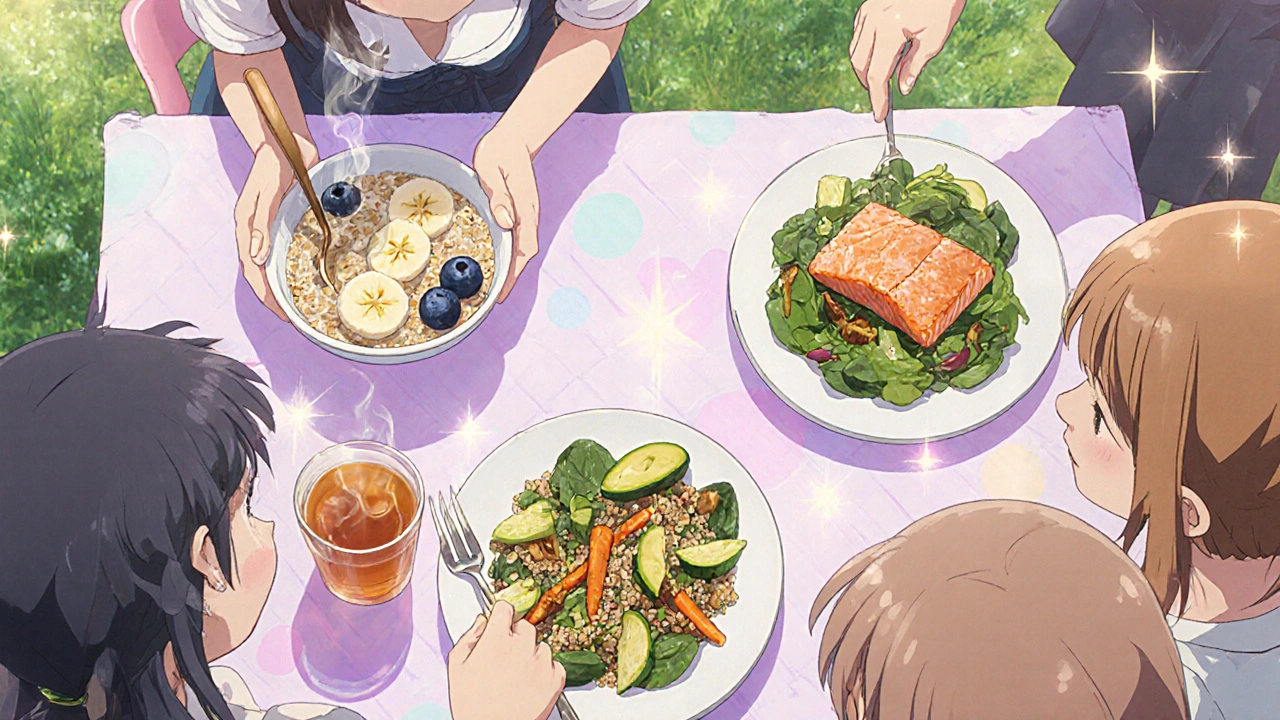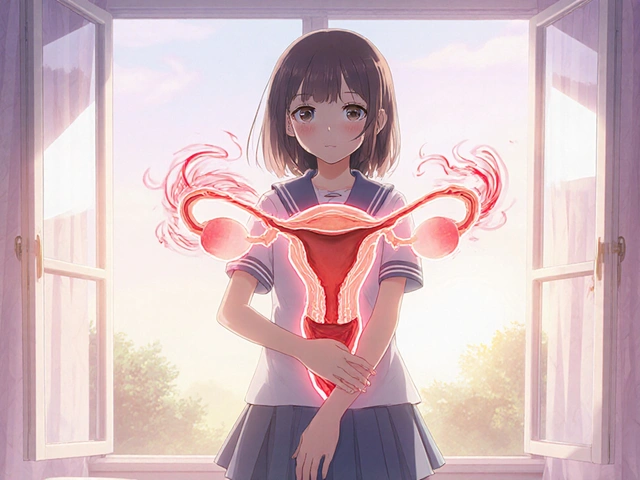Menstrual Cramps Food Checker
Enter any food or drink to check if it may worsen menstrual cramps. This tool identifies the main problematic foods based on medical research about prostaglandin production and inflammation.
When your Menstrual Cramps are caused by uterine muscle contractions that can range from mild to debilitating, the foods you eat can either calm the pain or make it flare up. Below you’ll find a practical guide that explains why certain ingredients aggravate cramps and which swaps keep you feeling steady throughout your cycle.
Why Your Diet Matters During Your Period
Every month the lining of the uterus builds up with blood and tissue. When it sheds, the body releases Prostaglandins hormone‑like compounds that trigger uterine muscle contractions. Higher levels of prostaglandins equal stronger squeezes, which we experience as cramps. Certain foods can increase prostaglandin production or cause inflammation, while others help the body produce anti‑inflammatory compounds that relax the uterus.
Foods That Can Worsen Cramps
Below is a roundup of the most common culprits. If you notice you’re reaching for any of these during a heavy week, try swapping them out with the alternatives listed later.
- Caffeine a stimulant found in coffee, tea, cola and energy drinks that can narrow blood vessels. Reduced blood flow means the uterus gets less oxygen, which can intensify pain.
- Alcohol a depressant that disrupts hormone balance and dehydrates the body. Dehydration raises the concentration of inflammatory compounds.
- Sugar especially refined sugars that cause rapid spikes in blood glucose. High glucose triggers insulin spikes, which can boost prostaglandin synthesis.
- Trans Fat artificial fats found in many processed snacks, fried foods and baked goods. Trans fats raise C‑reactive protein, a marker of inflammation.
- Sodium excess salt that leads to water retention and bloating. Bloating puts extra pressure on the uterus, making cramps feel tighter.
- FODMAPs short‑chain carbs that ferment in the gut, causing gas and bloating. The added pressure can intensify uterine contractions.
How to Replace Problem Foods
Swapping one ingredient for another is often enough to lower prostaglandin spikes and reduce inflammation.
- Swap coffee for a low‑caffeine herbal tea such as ginger or peppermint. Both herbs have natural anti‑spasmodic properties.
- Replace red wine with a glass of sparkling water infused with citrus; the electrolytes keep you hydrated without the dehydrating effect of alcohol.
- Choose whole fruit instead of candy or soda. The fiber in fruit slows glucose absorption, keeping insulin levels stable.
- Opt for avocado, nuts or olive oil instead of packaged cookies or microwave popcorn. These healthy fats contain omega‑3 fatty acids that directly counteract inflammation.
- Season meals with herbs, lemon juice, or potassium‑rich foods like bananas instead of a heavy hand of table salt.
- If you’re sensitive to FODMAPs, try low‑FODMAP vegetables (spinach, carrots, zucchini) and lacto‑fermented foods that aid digestion without bloating.
Comparison Table: Foods to Avoid vs. Cramp‑Friendly Alternatives
| Food to Avoid | Why It Hurts | Better Choice | How It Helps |
|---|---|---|---|
| Coffee / Energy Drinks | Vasoconstriction, spikes prostaglandins | Ginger tea, peppermint tea | Relaxing, improves blood flow |
| Alcoholic beverages | Dehydrates, raises inflammation | Infused sparkling water | Hydrates, no inflammatory load |
| Refined sugar, soda | Insulin spikes, prostaglandin boost | Whole fruit, berries | Fiber moderates glucose, antioxidants reduce inflammation |
| Trans‑fat snacks | Raises CRP, heightens pain perception | Olive oil, nuts, seeds | Omega‑3s dampen inflammatory pathways |
| High‑salt processed meals | Bloating, increased uterine pressure | Herbs, lemon, potassium‑rich foods | Reduces water retention, eases pressure |
| High‑FODMAP beans, onions | Gas, bloating, pressure on uterus | Low‑FODMAP veg (spinach, carrots) | Less fermentation, smoother digestion |
Quick One‑Day Meal Plan for a Low‑Pain Cycle
- Breakfast: Overnight oats with chia seeds, sliced banana, and a handful of blueberries. The magnesium in chia and the potassium in banana help relax muscles.
- Mid‑morning snack: A small handful of almonds and a cup of ginger tea.
- Lunch: Quinoa salad with spinach, roasted carrots, avocado, and a lemon‑olive‑oil dressing. The omega‑3s from avocado and the anti‑inflammatory lemon keep prostaglandin levels in check.
- Afternoon snack: Plain Greek yogurt topped with a drizzle of honey and a sprinkle of cinnamon (cinnamon can help balance blood sugar).
- Dinner: Baked salmon (rich in omega‑3) with a side of steamed zucchini and sweet potato. Sweet potato provides complex carbs that avoid glucose spikes.
- Evening wind‑down: Peppermint tea and a few squares of dark chocolate (70%+ cocoa) for magnesium.

Tracking Your Diet and Symptoms
Use a simple two‑column log: one side for everything you eat, the other for pain level (scale 0‑10). After a few cycles you’ll notice patterns - perhaps a coffee habit that lines up with 8‑10 pain scores. Adjust, re‑track, and you’ll build a personalized diet that eases cramps without sacrificing enjoyment.
Common Myths About Period Food
- Myth: You must eat “comfort food” like pizza to feel better.
Fact: Comfort foods often contain high sodium, trans fats, and refined carbs that actually heighten inflammation. - Myth: Dairy always makes cramps worse.
Fact: Full‑fat dairy can be fine for many; the problem is usually the added sugars in flavored yogurts. - Myth: Spicy food is a guaranteed trigger.
Fact: Capsaicin can increase circulation; for most people it doesn’t affect prostaglandins, but if you notice extra heartburn, tone it down.
Takeaway
Understanding the link between your menstrual cramps diet and the foods you choose empowers you to cut the pain at its source. By steering clear of caffeine, alcohol, excess sugar, trans fats, sodium and high‑FODMAP items, and swapping them for anti‑inflammatory alternatives, you can enjoy a smoother, happier period.
Which foods should I avoid the most during my period?
The top offenders are caffeine, alcohol, refined sugars, trans fats, high‑sodium processed foods, and high‑FODMAP carbs. These can raise prostaglandin levels or cause bloating, both of which intensify cramps.

Can I still have a small cup of coffee?
A tiny cup (under 100 mg caffeine) is usually okay if you pair it with plenty of water. If you notice a pain spike, switch to herbal tea instead.
Do all women react the same way to sugary foods?
No. Sensitivity varies with insulin response and personal metabolism. Track your own symptoms to see how sugar affects you specifically.
Is it okay to eat dairy during my period?
Plain, full‑fat dairy is fine for most people. Avoid flavored varieties that contain added sugars or artificial colors, which can trigger inflammation.
How long does it take to see results after changing my diet?
Most people notice a reduction in pain within one to two cycles, especially if they consistently avoid the main triggers and replace them with anti‑inflammatory foods.


Ankitpgujjar Poswal
October 19, 2025 AT 18:12Listen up, cutting out that extra espresso is not a suggestion – it's a necessity if you want those cramps to quit screaming. Grab a ginger tea, feel the heat, and tell your uterus to chill.
Bobby Marie
October 19, 2025 AT 18:45Skip the caffeine on heavy days.
Rakhi Kasana
October 19, 2025 AT 19:35The wave of pain that rolls in during that time of the month can feel like a storm in your belly, and you’re stuck watching it intensify because of sugar spikes. When you flood your system with refined carbs, insulin surges, and with it the prostaglandins that tighten your uterus. It’s not just a minor irritant; it’s a full‑blown siege on your comfort. By swapping that candy bar for a handful of berries, you give your body a chance to breathe, and the cramping eases like a tide pulling back. Remember, every small switch is a quiet rebellion against the pain.
Ben Bathgate
October 19, 2025 AT 20:42Honestly, most of these “food hacks” are just re‑packaged common sense, but the way they’re sold sounds like a miracle cure. If you’re already avoiding caffeine and sugar, you’ve done the heavy lifting. The real issue is inconsistency – you’ll still feel the burn if you slip up on the weekends.
Penny Reeves
October 19, 2025 AT 22:05It is evident that the author has touched upon the elementary biochemistry of prostaglandin pathways, yet the exposition suffers from a lack of scholarly depth. One would expect a more rigorous citation of peer‑reviewed literature when discussing anti‑inflammatory nutrients. Nonetheless, the pragmatic suggestions are serviceable for a lay audience.
Sunil Yathakula
October 19, 2025 AT 23:28Yo, totally get how hard it is to ditch that late night soda, but trust me, water with a slice of lemon does wonders for bloating. Keep track of ur cravings and you’ll see the cramp level drop, promise.
sravya rudraraju
October 20, 2025 AT 01:25When evaluating the interplay between dietary intake and menstrual discomfort, it is essential to adopt a holistic perspective that incorporates both physiological mechanisms and lifestyle variables. The uterine smooth muscle’s contractility is modulated principally by prostaglandin concentrations, which in turn are sensitive to macronutrient composition. Elevated consumption of refined carbohydrates precipitates hyperinsulinemia, thereby amplifying prostaglandin synthesis and intensifying cramp severity. Conversely, omega‑3 rich sources such as cold‑water fish provide eicosapentaenoic acid, a direct antagonist to the inflammatory cascade. Moreover, the role of electrolytes-particularly magnesium and potassium-cannot be overstated, as they facilitate neuromuscular relaxation and mitigate vasoconstriction. Hydration status further influences blood viscosity; dehydration augments vasospasm, narrowing uterine blood flow and exacerbating pain. In practice, substituting a daily espresso with a cup of ginger-infused tea introduces both anti‑spasmodic and antioxidant compounds, delivering a two‑fold therapeutic benefit. Replacing processed snack foods with whole‑food options such as almonds or avocado yields a favorable shift in lipid profiles, reducing C‑reactive protein levels. Incremental dietary adjustments are more sustainable than radical overhauls, allowing the body to adapt without triggering compensatory mechanisms. Tracking symptom severity alongside food logs provides empirical data, empowering individuals to personalize their nutritional strategies. Over the course of one to two menstrual cycles, many report a perceptible decline in pain scores, affirming the efficacy of these modifications. It is also prudent to consider individual variability; genetic polymorphisms in COX‑2 enzymes may render some women more responsive to dietary influences. Therefore, while the principles outlined are broadly applicable, personalization remains paramount. In sum, a diet low in caffeine, alcohol, refined sugars, trans fats, excess sodium, and high‑FODMAP items, complemented by anti‑inflammatory alternatives, constitutes a robust framework for cramp mitigation. Integrating these practices with regular physical activity and stress‑reduction techniques further amplifies the therapeutic outcome. Ultimately, informed dietary choices empower women to reclaim agency over their menstrual health.
Christopher Burczyk
October 20, 2025 AT 03:55The presented meal plan demonstrates a commendable balance of macronutrients and micronutrients, yet it omits mention of vitamin D’s role in modulating inflammatory responses. Incorporating fortified dairy or safe sun exposure could enhance the anti‑inflammatory profile.
dennis turcios
October 20, 2025 AT 06:25While the article covers the basics, it fails to address the nuanced differences in individual glycemic responses, which can affect prostaglandin levels. A more tailored approach would be beneficial.
Felix Chan
October 20, 2025 AT 08:55Great job sharing these tips – I’m already swapping my afternoon coffee for peppermint tea and feeling the difference! Keep the positive vibes coming.
Thokchom Imosana
October 20, 2025 AT 11:25It’s no coincidence that mainstream nutrition guidelines continue to push processed sugars; corporate interests profit from the very inflammation they claim to combat. By recognizing the hidden agenda, we can reclaim control over our bodies and select truly wholesome foods that aren’t part of the profit‑driven narrative. The alternative foods suggested here bypass the commercial pipeline, offering a grassroots solution to a problem engineered by the industry.